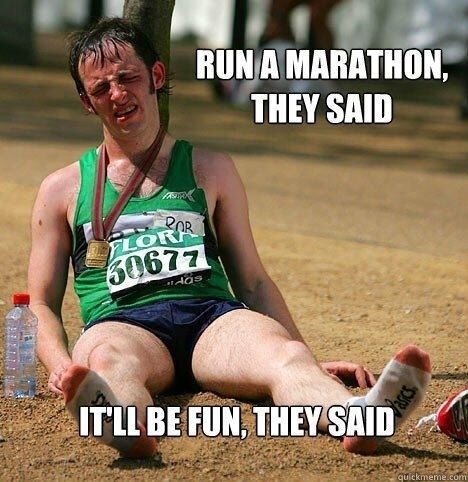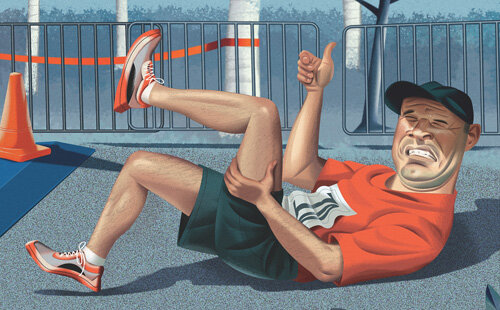How CrossFit Can Help Runners Pt. 1
This series of articles will dive into how runners can maximize their training hours, improve their overall health and wellness and greatly reduce the risk of injury, all while they still improve their running times. It will aim to help recreational / amateur runners see that you can spend more time with your family, have better energy and presence (not beat down and tired), and still enjoy the running community. I'm writing these because I have had so many broken down runners join our facility with mechanical issues, joint pain and flexibility problems that take years to reverse. I see an easier way, and I hope it can help a few people make better, more informed decisions about their approach to running, health and fitness. Running has become a staple for people looking to get off the couch, to begin a life of exercise and activity. Of course it is, the requirements are minimal and for the most part everyone can do it with varying degrees of effectiveness. I love so much about running and what it does for the mind and body. I love that it can be the start of major weightloss and health-conscious thinking. I love that it is performance focused. However, much like CrossFit, Google has become a place to easily remove quality programming and coaching designed specifically to you, in place of a cookie-cutter, one size fits all program (Check out "Couch to Marathon"'s competition for top spot on Google) -- and that has led to some dangerous training habits in the community. (I found this article to quickly and briefly lay out major issues) Why is this important? First, all athletes have very specific needs. Someone googling these training programs might be a 140lb former Cross-Country runner with perfect running mechanics and thousands of quality reps under his belt, while the next person who finds it might be 300lbs and not be able to get into a stride, and the next might have horribly weak glutes and hamstrings, a poor diet and their body will break down within the first 2 weeks. Without someone assessing you, and knowing specifically your body's needs and weaknesses, you are at a very high risk of injury picking a training program off the internet.Wouldn't you like to know if a decision you're making to spend hundreds of hours of your life was the right one for you before you did it?This same thing attacked the sport of CrossFit a few years ago, where top competitive athletes began putting their programming out to the world. These are athletes who have teams of chiropractors, massage therapists, nutritionists and a full staff of coaches and training partners. They also have a fully open training schedule, can maximize 10-12 hours of sleep + flawless recovery habits after workouts. Their life and habits allow them to carry out the program. Recreational & Amateur athletes got a hold of these like kids with crack. Random Instagram workouts started taking over thoughtful, designed programming from a trained coach. Running has been stuck here for years, programs designed with rapid increases in mileage and time, without any thought to recovery, form or mechanics first.How did we get here? In America in the 90's/early 2000's (What will go down as one of the darkest periods of health and fitness ever), people were entirely lost in the gym. Gym's had removed free weights in support of scores of machines and ellipticals. They reduced rates down to comical levels, preferring (requiring) that paying members DON'T SHOW UP, and removed quality fitness coaches almost entirely from existence. This led people to start looking to magazines, then to websites for workouts. Find a top-athlete in a sport, and search "name + workout" and (if it's a man) inevitably, Men's Fitness has an article on them (George St. Pierre, Lebron, JJ Watt). Our society's health was now in the hands of magazines and the internet, where dollars (not experience, science or logical thought) reign supreme.So, we must begin anew. We've lost a generation of quality coaches who couldn't support themselves because Planet Fitness is now a $3,000,000,000 (yes, billion) company...$9 at a time. Ellipticals and machines have removed a human's need to have proprioception, core stabilization, hip mobility and coordination. Running clubs often don't work on running form, body mechanics, strengthening or proper recovery protocols. Large scores of runners have terrible nutrition, and often are out there as punishment to themselves for eating poorly (sorry guys, things don't work that way). Runners pride themselves not on quality of training, but in time / miles completed (the CrossFit equivalent to bragging about doing 6-MetCons a day).We can help, we do have answers, but it will take an open mind and commitment to doing things the SMART way, not the hard way. I'm thankful to say that we have created a team that is thoughtful and intelligent in it's approach to health and wellness, and we have developed the coaches necessary to help people where they have struggled for the past two decades. In Part 2, we'll look into how accessory work & strength training can greatly increase your running ability and decrease your risk of injury -- and how you can fit that into your training week appropriately.If you know you need help, you may contact us here.Author Jeff Binek is the Owner of Friendship CrossFit. Prior to becoming a world-class fitness coach he was the leader of an elite Infantry unit in the US Army. Jeff has coached hundreds of athletes to massive running PRs with fewer training hours. At 220lbs, Jeff still runs a sub-5:30 mile and sub-20 5k, on less than 30 running workouts / year with less back and knee pain than he experienced in his 20's.
Why is this important? First, all athletes have very specific needs. Someone googling these training programs might be a 140lb former Cross-Country runner with perfect running mechanics and thousands of quality reps under his belt, while the next person who finds it might be 300lbs and not be able to get into a stride, and the next might have horribly weak glutes and hamstrings, a poor diet and their body will break down within the first 2 weeks. Without someone assessing you, and knowing specifically your body's needs and weaknesses, you are at a very high risk of injury picking a training program off the internet.Wouldn't you like to know if a decision you're making to spend hundreds of hours of your life was the right one for you before you did it?This same thing attacked the sport of CrossFit a few years ago, where top competitive athletes began putting their programming out to the world. These are athletes who have teams of chiropractors, massage therapists, nutritionists and a full staff of coaches and training partners. They also have a fully open training schedule, can maximize 10-12 hours of sleep + flawless recovery habits after workouts. Their life and habits allow them to carry out the program. Recreational & Amateur athletes got a hold of these like kids with crack. Random Instagram workouts started taking over thoughtful, designed programming from a trained coach. Running has been stuck here for years, programs designed with rapid increases in mileage and time, without any thought to recovery, form or mechanics first.How did we get here? In America in the 90's/early 2000's (What will go down as one of the darkest periods of health and fitness ever), people were entirely lost in the gym. Gym's had removed free weights in support of scores of machines and ellipticals. They reduced rates down to comical levels, preferring (requiring) that paying members DON'T SHOW UP, and removed quality fitness coaches almost entirely from existence. This led people to start looking to magazines, then to websites for workouts. Find a top-athlete in a sport, and search "name + workout" and (if it's a man) inevitably, Men's Fitness has an article on them (George St. Pierre, Lebron, JJ Watt). Our society's health was now in the hands of magazines and the internet, where dollars (not experience, science or logical thought) reign supreme.So, we must begin anew. We've lost a generation of quality coaches who couldn't support themselves because Planet Fitness is now a $3,000,000,000 (yes, billion) company...$9 at a time. Ellipticals and machines have removed a human's need to have proprioception, core stabilization, hip mobility and coordination. Running clubs often don't work on running form, body mechanics, strengthening or proper recovery protocols. Large scores of runners have terrible nutrition, and often are out there as punishment to themselves for eating poorly (sorry guys, things don't work that way). Runners pride themselves not on quality of training, but in time / miles completed (the CrossFit equivalent to bragging about doing 6-MetCons a day).We can help, we do have answers, but it will take an open mind and commitment to doing things the SMART way, not the hard way. I'm thankful to say that we have created a team that is thoughtful and intelligent in it's approach to health and wellness, and we have developed the coaches necessary to help people where they have struggled for the past two decades. In Part 2, we'll look into how accessory work & strength training can greatly increase your running ability and decrease your risk of injury -- and how you can fit that into your training week appropriately.If you know you need help, you may contact us here.Author Jeff Binek is the Owner of Friendship CrossFit. Prior to becoming a world-class fitness coach he was the leader of an elite Infantry unit in the US Army. Jeff has coached hundreds of athletes to massive running PRs with fewer training hours. At 220lbs, Jeff still runs a sub-5:30 mile and sub-20 5k, on less than 30 running workouts / year with less back and knee pain than he experienced in his 20's.

